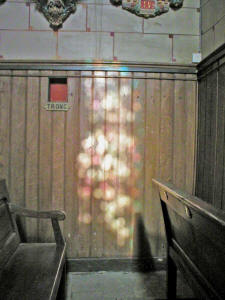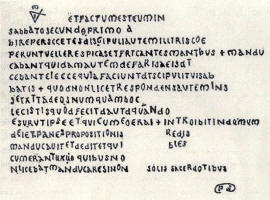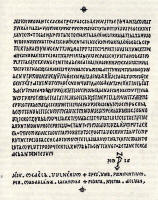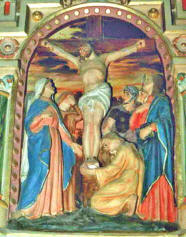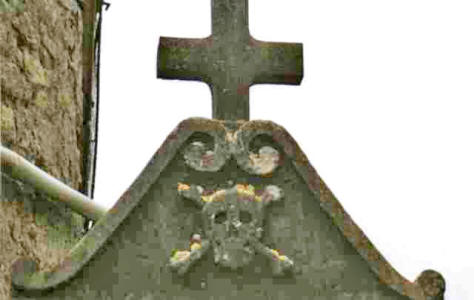|
by Tracy R. Twyman and Boyd Rice from DagobertosRevenge Website
recovered through
WayBackMachine Website Part 1
It’s been centuries since the Albigensian Crusade, but signs on the freeway constantly remind you you’re in "Cathar Country." A sign with a picture of a pig superimposed upon a family having a barbecue reads, "Demand pork in Cathar country - It’s part of a tradition of good taste" - never mind the fact that the Cathars were strict vegetarians. Pull into a roadside shop and you can get Cathar soap, Cathar letter openers, and even Cathar wine (to go with the pork, we presume.)
There’s even a museum called the Catharama.
The Cathars may have been wiped out by the Inquisition in the 13th century, but they live on as a powerful source of tourism in this part of the world where seemingly nothing else of consequence has taken place in the intervening 700 years.
It was in this village that a poor parish priest named Berenger Sauniere discovered 4 parchments that were to change his life, and the surrounding village, forever. Two of these parchments were genealogies of this magazine’s mascot, Dagobert II, the last of the Frankish dynasty of Priest-Kings known as the Merovingians.
The other two contained ciphered messages which, when decoded, displayed the following:
click image to enlarge
(Blue Apples at
Midday) on 17 January 2005 . After finding these parchments (click below images), this once-poor parish priest became suddenly and inexplicably wealthy, perhaps because of having found some buried treasure.
He started hanging out with members of the Parisian upper-crust occult set, such as composer Claude Debussy and opera singer Emma Calve. He began redecorating his church and surrounding property in a most bizarre fashion, leaving behind strange clues in an effort to communicate to future generations the secret that he had learned from the parchments.
These clues, many involving the use of occult, qabalistic, alchemical, Masonic, and Templar-oriented symbolism, seem to indicate the involvement of a secret society known as the Priory of Sion, who were and are dedicated to the preservation and support of the Merovingian bloodline, which they claim, contrary to popular belief, has survived until the present day.
Sauniere’s clues lead to the unshakable conclusion that Jesus did not die on the cross, that he fled to France with his pregnant wife, Mary Magdalen, and that his descendants intermarried with local Visigothic royalty to eventually become the Merovingian dynasty.
They also indicate that an artifact
commonly known as the ’Holy Grail’ may be found there as well. These
clues led us and a five-man Fox television crew out to Rennes-le-Chateau
in October, of 2000.
We got the feeling that our hosts knew a lot more about the mystery of the nearby village then they let on, a feeling that was confirmed later when we found an empty bottle of "Berenger Sauniere" brand wine, with a picture of the priest on the label in the hotel dining room.
On the very first evening, the Fox crew took us to the church grounds to scout the location. Having both studied the subject of Rennes-le-Chateau with enthusiasm for a number of years, it would be an understatement to say that our first glimpse at this mysterious property was absolutely overwhelming. We’d heard Henry Lincoln talk about the "stunningly beautiful landscape" in his documentaries before, but the natural grandeur of the scenery is minisculed by the drab medium of videotape. We pulled up next to the Tour Magdala and clamored out of the car.
Immediately we noticed something that previous authors had not commented upon - a long, slender window with the bricks around it shaped like the Cross of Lorraine. Around the corner was another tiny window, and Tracy had the pleasure of climbing up the side of the tower in high-healed plastic boots in order to get a peek inside, but all she could see were some dusty old tables.
On the opposite side, protected by a
thick fortress of bramble bushes was a crude Templar cross etched
into the brick, probably by some modern graffiti artist. After that,
we walked over to the Church, and for the first time laid eyes upon
the House of God that hid so many terrible secrets. We searched for
the curse that Sauniere had placed over the door, "This Place is
Terrible", but unfortunately, it was covered with scaffolding. No
one was there, though, so Tracy took the opportunity to climb all
over the grotto, which held a tiny little statue of Mary Magdalen,
and which, Boyd noted, was oddly made of coral.
This was not discouraging to us in the least. For every fascinating, mysterious fact that turned out to be either made up or misinterpreted, we learned or discovered half a dozen true mysterious facts that have never been noted before in the genre literature.
We’d always read about the statement "This Place is Terrible" above the church door, which is a quote from Genesis, where Jacob falls asleep on a stone and has a vision of a ladder leading up to heaven, with angels ascending and descending.
This, of course, is the same Stone of Destiny brought to Scotland by Joseph of Arimathea, and became the stone upon which British monarchs are coronated, even today.
What’s
noteworthy is that beneath the words "This Place is Terrible" on the
doorway, the sentence seems to be completed by the words, in Latin,
"But this is the House of God and the Gateway to Heaven", making it
not a curse but a statement upon the dual nature of divinity. There
is also quite a bit of iconography etched over the doorway that has
not been previously noted, including two Templar crosses, two
Crosses of Lorraine, and the Masonic image of the Blazing Star that
falls from the Heavens to enlighten mankind.
Above the fountain are two fire-breathing salamanders, and above them, four ceramic statues of angels making the sign of the cross, with the caption "In Hoc Signo Vinces" - "In this sign you will conquer." The entire display then, can be taken to represent a "marriage" or "crossing" of the four elements.
Each element of this configuration represents one of the four primary elements of magic or alchemy:
Across the hall from the demon stand statues of Christ kneeling before John the Baptist, a sorrowful look on his face, waiting to be blessed.
As has been previously stated, all of these statues are looking at the floor, tiled in the black and white "Chessboard" style used by Templars and Freemasons to symbolize the co-equal powers of light and darkness.
Another noticeable variation from popular myth is that in the Station of the Cross with the black child wearing the supposed "Scottish kilt", he is actually wearing some kind of yellow and orange grass skirt. The Station with Christ being placed inside the tomb, or perhaps, as many have claimed, being removed from the tomb, is indeed as peculiar-looking as people have said, and a few Stations previous, as Christ is hanging on the cross, a couple of red lightening bolts in the shape of Sig runes can be seen.
Across the hall, there are two figures of Christ, seemingly identical in representation, and placed in such close proximity to one another that one could not help but notice the seeming redundancy. Both Christs are pointing skyward with their right forefinger, and are separated by a few feet, with one situated just above the other.
Closer inspection reveals that they
aren’t identical, despite initial appearances. The one on the bottom
holds a symbol of Papal authority in his left hand, and is
surrounded by his chief disciples. The one above, whom the lower one
points up towards, stands alone. His left hand is at his side
pointing down, ala the Eliphas Levi etching of Baphomet. This
Christ, placed as he is above the other, seems to indicate that he
stands above the Christ of orthodox Christianity. And if one follows
the path of his pointing finger, he seems to be pointing to a cupola
affixed to the wall far above him. At the top of the cupola is the
sign of the rosy cross.
Except for the
inscriptions reading "St. Joseph" and "St. Virgin Mary", one could
easily mistake this couple for Christ and Mary Magdalen. Is this
meant to tell us that Christ and Mary had two sons, perhaps even
twins? Wherever one encounters these dual sets of two, a coded story
is told. Most often, the story echoes the thesis of Holy Blood, Holy
Grail, but often it hints at something more.
This, some say, represents the bloodline of Christ living on after his death. Above this scene is the depiction of a Holy chalice with a sunshine shape descending into it.
The sun is often used to represent the alchemical Philosopher’s Stone, and the Grail is often depicted as a stone inside of a cup. But the predominant symbol found in the church is not Christ, not Mary Magdalen, but the Rosy Cross. It’s everywhere - above Christ, above John the Baptist, even above Asmodeus. And it is above every station of the cross.
It is depicted both as a red Christian cross, and as an equilateral Templar-type cross with a rose at the center. The only symbol that is more prevalent than the Rose Cross is one not commonly found in most Catholic churches - the Fleur-de-lys. The confessional is covered with stylized fleur-de-lys. Christ is crucified on a cross whose ends blossom out into fleur-de-lys. The ends of the rosy cross turn into fleur-de-lys.
A series of intersecting circles on the wall are decorated with the letters "S.M." (Saint Mary), and gold fleur-de-lys. This monarchist symbol is more prevalent here than any Christian symbol, and surprisingly, no previous researchers have seen fit to comment on it. This is odd, because surely this recurring motif is intended to indicate a connection between the Grail family and French royalty, and as such would represent a strong piece of circumstantial evidence in favor of the "Holy Blood, Holy Grail" theory.
Yet it seems to have gone unnoticed.
It’s strange that someone of importance was brought all the way to
this obscure location, and stranger still that their name has been
forgotten by history. And it’s yet another indication that this
place was viewed to be important even in the distant past, centuries
before the whole Sauniere affair.
It seems that only members of certain noble families in the area were allowed to attend this church, with the peasants being assigned to another across the way, and each attendant had an assigned seat number. These seat assignments would be changed every season, with a different section of the pews left clear each time.
Our tour guide believed that these sections were being left unused because Sauniere was digging under those particular areas at the time. We also learned that there seems to be a disagreement about which pillar Sauniere found the parchments in. One candidate, which she showed us, is a wooden pillar that’s hollow with a removable piece on top, then there’s the famous "Visigothic" pillar, which bears the words "MISSION 1891", the date that the town’s children were confirmed in the Catholic Church.
This pillar had been holding up the altar, but Sauniere had it turned upside down so that it read "1681", and the words "Peace 681" were mysteriously mentioned in the parchments he found. Interestingly, 1891 is the same date that can be found etched next to an inscription on a rock at nearby "Lover’s Fountain" that reads "E. Calve", illustrated by a heart with an arrow through it.
Henry Lincoln believes that this is an
artifact of Sauniere’s love relationship with Emma Calve, but our
tour guild assured us that "there is absolutely no evidence that
Calve and Sauniere ever knew each other!" Yet she also told us that
there was no evidence for a connection between Rennes-le-Chateau and
the Knights Templar, and considering the Templar imagery were had
already seen, it was hard to take her dogged assertions too
seriously.
It just so
happens that at sundown every night, the real sun shines directly
onto the sun shape behind Christ’s head and reflects onto the mirror
behind Mary Magdalen’s head. Because the sun metaphorically
represents the seed of God inseminating the Earth, we speculate that
this represents the seed of Christ inseminating the Magdalen. It is
on this same Calvaire that we find the words (in Latin) "Christ
Defend - AOMPS", which Henry Lincoln says stands for "Ancient
Mystical Order of the Priory of Sion."
In the hallway, we were shown how one of the tiny square tiles on the tile floor was a different color from the rest, indicating that some of the treasure might be buried there. Outside, underneath the "Glass Tower" is another set of 22 steps leading down into a dark basement which we were not allowed to visit, and nearby, two sets of 11 stairs each leading down into the garden.
There Jane showed us a huge tunnel which someone had haphazardly dug underneath the foundation of the Tower. As we made out way into the graveyard, she pointed out that on the Skull & Crossbones above the gate (a Templar and Masonic symbol, by the way), the skull has 22 teeth.
Then, embossed onto the gate
itself, we noticed another Masonic symbol: the winged hourglass, an
emblem of fleeting time, and the temporary nature of our short
lives. But unlike the angelic wings we usually see with this symbol,
we noted that these wings were distinctly bat-like, emphasizing the
demonic and infernal themes at Rennes-le-Chateau.
The Blancheforts were
related by blood to the Merovingians, and one of the Blancheforts
had been a Grand Master of the Knights Templar at one point.
Furthermore, it was the gravestone of Marie de Blanchefort, once
situated in Sauniere’s graveyard, that had at one time been
inscribed with a coded cipher which contained the coded message "Et
in Arcadia Ego"., which relates to the Rennes-le-Chateau mystery.
Following lunch, it was time for our interviews.
For instance, many still dismiss the Priory of Sion as a mere hoax, yet it can be demonstrated that as early as the late 1940s the Priory was advocating a United Europe; and today the European Union is a reality (complete with an emerging single currency.) The emblem that the Priory suggested for a United Europe was a circle of stars - the very emblem that adorns the flag of today E.U. Coincidence?
The specific bloodline that the Priory
was so obsessed with was that of Dagobert II and Godfroi de Boullion
- a bloodline from which numerous U.S. Presidents have claimed
descent (up to and including the Bush family.) While it is easily
conceivable that any organization could construct for themselves a
false pedigree by stringing together bits and pieces of past
history, the main thrust of the Priory’s agenda in the 1940s
involved developments that wouldn’t become part of history for
nearly another half-century. In other words, it is impossible to
’fabricate’ what hasn’t yet happened.
She stumbled up to us while we were getting ready to tape and slurred,
And on and on like
this for 45 minutes without taking a breath. The group listened
politely, all the while wondering who on Earth this woman was. And
too, who the fuck was Martin?
Toward the back wall was a wooden door, nailed permanently shut with an ancient rusted nail. It had been a closet, we were told, but the closet had featured a secret panel in the back that lead to Sauniere’s secret room. Jane had no idea how long the room had been sealed off, but with a little coaxing, saw no reason why we couldn’t pry out the nail and have a peek inside. So we pried out the nail, popped open the secret panel, and stepped inside Berenger Sauniere’s legendary treasure room.
We couldn’t help wondering who had last come into this place, or whether any of the writers who’d referred to this room had ever laid eyes upon it. The floor of the room was dirt. Whatever floorboards were once here had long since been torn up, and the dirt was soft from digging. A pile of rubble was heaped into one corner. From ground level, one could peer beneath the floor of the sacristy, but there was little to see except cobwebs and mounds of oxidized dirt that looked as though it hadn’t been disturbed for centuries.
The room was decaying, squalid, and entirely unimpressive, and yet would couldn’t lose sight of the fact that within this filthy cubicle with its peeling paint, a great treasure of some sort had at one time been secreted away. Were we standing in the same confines that once housed the treasure of the Cathars? The Templars? King Solomon’s Temple? Could it be that the Ark of the Covenant once rested in this very spot?
Whatever Sauniere had discovered had once, no doubt, been hidden here. Why else would a priest create a secret room that could only be accessed via a closet and secret panel?
A secret room is testament to a secret. That secret had once
come to rest within these very walls. And though it had long since
been removed, we could feel its presence. Whatever it had been was
still here, someplace. All the symbolism seemed to point to this. It
was up to us, somehow, to grasp the esoteric meaning inherent in the
symbolism … if we could.
Could Sauniere himself have added this embellishment while he was still alive?
There was no telling how
many years this oddly-shaped piece of rock had laid at the other
side of the cemetery until we happened upon it. Looking at old
photos or footage of the stone bearing Sauniere’s profile was no
help in making a determination, because except for a few hours each
day when the position of the sun cast a harsh shadow, the alteration
was so subtle as to be virtually imperceptible. Any person viewing
the stone in the morning or afternoon could easily never have
noticed anything out of the ordinary.
Every mythology or religious ideology
has some specific geographical location they declare to be the
"center-point of the world." At one time, Solomon’s Temple was
claimed to be such a place. Heinrich Himmler maintained that his
Grail castle, the Wewelsburg, was such a spot. And of course, for
Islam, Mecca is the world’s center-point. Clearly, this was no
ordinary small town Mayor. He obviously viewed Rennes-le-Chateau not
as a mere township, but as a holy place.
This is a rather stunning piece of information, because just a few days before, we’d discovered the existence of a little-known painting by Nicholas Poussin entitled Flight to Egypt, and it depicted the holy family fleeing to Egypt following the crucifixion.
To the best of our knowledge, no Grail researchers have even hinted that Christ’s family had gone to Egypt prior to leaving for France, and now this strange gentleman was confirming what we’d assumed was a wholly unique discovery.
Part 2
He’d discovered a book which is the oldest book ever written in Europe, and the title translates to "History of Atlant." He said that Atlant is the name of the place and that "Atlantis" really means "Atlantish" or somebody from Atlant. He showed us this book. There were indeed many recognizable words in there, and they were written in characters that were more than a little bit Runic.
We inquired as to the original meaning of the word "Cathari", and he explained that it was a conjunction of "cat" and "ari." "Ari", he told us, was the same as "Aryan", meaning "noble", "lofty one", "shining one." This much we know. So the Cathars were Aryans and Cats. Who then were the Cats? "Cats", he replied. "You know, cats." One of us made a meowing sound, almost as a joke. "Yes!", he exclaimed. "Cats, as in Catholic or Catalonia - cats!" The guy was totally brilliant, but who knows - he may well have been a nut.
For all intents and purposes, this seemed to be perhaps the most straight-forward picture in the whole place, and yet, there seems to be something strange about it. We are told that this piece was Sauniere’s pride and joy, and he even hand-painted it himself, taking great pains so that this "centerpiece" to his church would be perfect. And indeed, the priest did a masterful job on some parts of the painting.
The Magdalen is perfect, as is the sunset and foliage just behind her. Yet the interior of the cave in which she is kneeling is inexplicably blotchy and inconsistent in its coloring. It’s a mishmash of dark and light patches with messy lines running this way and that. It almost seems as though the apparently random smears of paint on the right side of the painting are echoing the curves and lines on the left side. And closer inspection seems to confirm this.
Although it is so incredibly subtle as to be virtually subliminal, it appears that the numerical 22 has been secretly embedded in the painting. We know that 22 is one of Sauniere’s secret codes, and we would see the number repeated profusely in the coming days, but this example of it is so excruciatingly understated that we wonder if perhaps we aren’t simply hallucinating. We scrutinized the painting more closely and almost immediately a tell-tale angle leapt out at us. It clearly seems to be part of a five-pointed star - a pentagram, such as Poussin and Cocteau also encoded into their work.
One side of the angle is delineated by the mouth of the cave, the other by the blanket wrapped around Mary’s hips. Extending the lines of the angle beyond the borders of the painting, it seems plain that the cross upon which the Magdalen gazes falls directly in what would be the center of the pentagram. So far as we’re aware , this would represent the first time anyone has ever demonstrated the use of pentagonal geometry actually within the Church of Rennes-le-Chateau, and not just as it applies to the local landscape.
The symbol is so central to the mystery of Rennes-le-Chateau
that it’s not at all surprising that Sauniere should employ it; what
shocks us is that in all these years no one else has ever recognized
that he had. As the days passed we were to discover that there was
much at Rennes-le-Chateau that had gone unnoticed. And many of the
people who write about this mystery had never even been here.
For
instance, certain incongruous bits of iconography inside the chapel
seem to be echoed in the cemetery. This, in turn, leads you to
something else yet again. Slowly, one becomes aware that a pattern
is emerging. A story is being told not in the mere details of the
symbolism, but in the correlations between those details.
They offer explanations such as "22 is a very important number in the occult", yet stop short of saying why it’s important in an occult context. We hypothesized that 22 didn’t refer to anything that actually numbered 22 (such as steps from point A to point B, etc.), but served as a starting point from which further decoding should proceed. Adding the digits together, as in numerology, results in 4.
The most obvious appearance of 4 in the
chapel is the depiction of the four elements (Earth, Air, Fire,
Water) just inside the door. These are the elements spelled out in
Hebrew characters that comprise the Tetragrammaton, IHVH (Jehovah),
and the fourth letter of the alphabet is D, the first letter of
Dieu,
the French word for God. This was far too simple an explanation - it
had to be something else.
Wherever we encountered these anomalies, a coded story was told. Collectively, these stories seem to relate much the same tale hypothesized by Henry Lincoln, though they also indicate that the scope of the whole saga extends way beyond anything previously hinted at.
We had expected as much, and much of
what we discovered seemed to confirm a number of theories we’d had
that deviate radically from the common wisdom regarding this
mystery. Unfortunately, it’s not possible for us to go into detail
about our theories and discoveries at this time, as we intend to
publish a book about this sometime in the coming year.
Enlarging an aerial photograph of Sauniere’s domain, we drew across it so as to intersect the first set of landmarks. A line through a second set of landmarks intersected the first at a location not terribly far away. Given the grand scale of the property’s layout and design, we’d assumed that the lines might possibly converge on some nearby mountaintop, but this was a mere stone’s throw away.
Drawing a line through what
seemed to be the third major set of landmarks yielded more than we
dared expect. It intersected the first two lines in precisely the
same spot.
At any rate, we had come to Rennes-le-Chateau fully confident that we would discover much that had escaped the scrutiny of previous researchers, and indeed we had. Far too much, in fact, to fit within the confines of a short magazine article.
The bits and pieces we’ve detailed here represent a small fraction of what we found at Rennes-le-Chateau, the proverbial tip of the iceberg. Not only did Rennes-le-Chateau live up to our expectations, it far exceeded them.
And in so doing, the place has become for us (as for the Mayor) the center point of the world.
|

